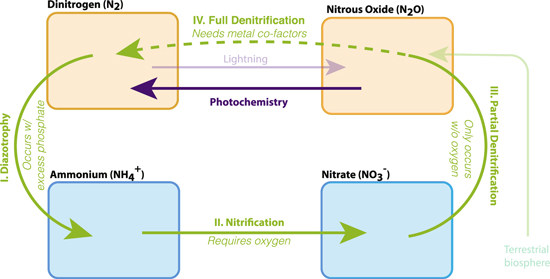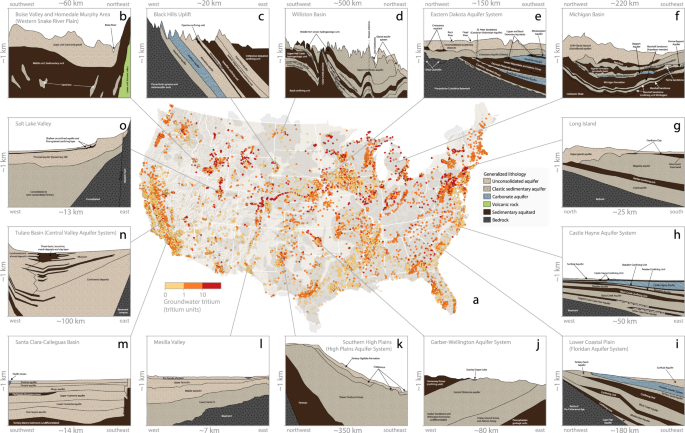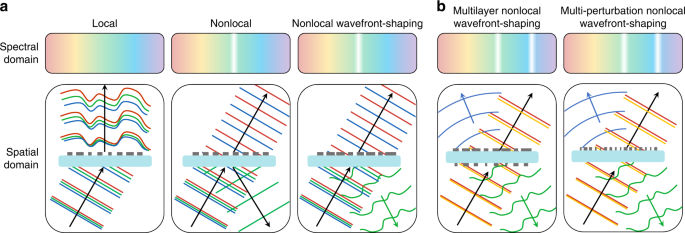太陽系外惑星ハンターはN2Oの有無を確認すべき Exoplanet hunters should check for N2O
2022-10-04 カリフォルニア大学リバーサイド校(UCR)
生物が亜酸化窒素(N2O)を生成する方法は複数ある。微生物は常に他の窒素化合物をN2Oに変換しており、この代謝プロセスは有用な細胞エネルギーを生み出すことができる。
N2Oをバイオシグネチャー・ガスとして考えたことのある他の研究者は、N2Oをはるか彼方から検出するのは難しいだろうと結論付けることが多い。この結論は、現在の地球の大気中のN2Oの濃度に基づいている。生命にあふれたこの惑星にはあまり存在しないので、他の場所でも検出は難しいだろうと考える人もいる。
また、K矮星やM矮星などの一般的な星は、太陽よりもN2O分子を分解するのに弱い光のスペクトルを出すという。この2つの効果が組み合わさることで、人が住む世界で予測されるこのバイオシグネチャーガスの量が大幅に増加する可能性がある。
<関連情報>
- https://news.ucr.edu/articles/2022/10/04/laughing-gas-space-could-mean-life
- https://iopscience.iop.org/article/10.3847/1538-4357/ac8cfb
地球外生命体におけるN2Oバイオシグネチャの推定可能範囲の評価。生物地球化学、光化学、スペクトルの統合的モデリングによるアプローチ。 Evaluating the Plausible Range of N2O Biosignatures on Exo-Earths: An Integrated Biogeochemical, Photochemical, and Spectral Modeling Approach
Edward W. Schwieterman, Stephanie L. Olson, Daria Pidhorodetska, Christopher T. Reinhard, Ainsley Ganti, Thomas J. Fauchez, Sandra T. Bastelberger, Jaime S. Crouse, Andy Ridgwell, and Timothy W. Lyons
Astrophysical Journal Published:2022 October 4
DOI:http://doi.org/10.3847/1538-4357/ac8cfb.

Abstract
Nitrous oxide (N2O)—a product of microbial nitrogen metabolism—is a compelling exoplanet biosignature gas with distinctive spectral features in the near- and mid-infrared, and only minor abiotic sources on Earth. Previous investigations of N2O as a biosignature have examined scenarios using Earthlike N2O mixing ratios or surface fluxes, or those inferred from Earth’s geologic record. However, biological fluxes of N2O could be substantially higher, due to a lack of metal catalysts or if the last step of the denitrification metabolism that yields N2 from N2O had never evolved. Here, we use a global biogeochemical model coupled with photochemical and spectral models to systematically quantify the limits of plausible N2O abundances and spectral detectability for Earth analogs orbiting main-sequence (FGKM) stars. We examine N2O buildup over a range of oxygen conditions (1%–100% present atmospheric level) and N2O fluxes (0.01–100 teramole per year; Tmol = 1012 mole) that are compatible with Earth’s history. We find that N2O fluxes of 10 [100] Tmol yr−1 would lead to maximum N2O abundances of ∼5 [50] ppm for Earth–Sun analogs, 90 [1600] ppm for Earths around late K dwarfs, and 30 [300] ppm for an Earthlike TRAPPIST-1e. We simulate emission and transmission spectra for intermediate and maximum N2O concentrations that are relevant to current and future space-based telescopes. We calculate the detectability of N2O spectral features for high-flux scenarios for TRAPPIST-1e with JWST. We review potential false positives, including chemodenitrification and abiotic production via stellar activity, and identify key spectral and contextual discriminants to confirm or refute the biogenicity of the observed N2O.



